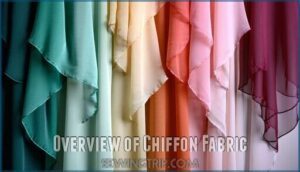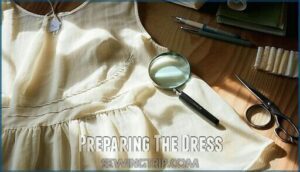This site is supported by our readers. We may earn a commission, at no cost to you, if you purchase through links.
 You can shrink chiffon fabric by washing it in hot water and using high heat while drying.
You can shrink chiffon fabric by washing it in hot water and using high heat while drying.
The method depends on your chiffon’s material – polyester chiffon resists shrinkage more than silk or cotton varieties.
Start by checking the care label, then wash in the hottest water recommended.
For faster results, you can use the hairdryer method on damp fabric, moving the dryer constantly to avoid damage.
Remember that silk chiffon requires gentler handling than synthetic versions.
Different chiffon types respond differently to heat, so understanding your fabric’s composition makes all the difference in achieving the perfect fit without ruining your garment.
Table Of Contents
- Key Takeaways
- Can Chiffon Fabric Shrink?
- Methods for Shrinking Chiffon
- Shrinkage Based on Material
- Effective Practices for Shrinking Chiffon
- Considerations for Different Fabrics
- Intentional Shrinking of Clothes
- Overview of Chiffon Fabric
- How to Shrink a Chiffon Dress
- Some Things to Consider
- Frequently Asked Questions (FAQs)
- Conclusion
Key Takeaways
- Check your fabric type first – Polyester chiffon resists shrinkage more than silk or cotton varieties, so you’ll need different heat levels and methods depending on what you’re working with.
- Use hot water washing for best results – Wash in the hottest water your fabric can handle (around 120-140°F), then air dry flat or use medium heat in the dryer while monitoring closely.
- Try the hairdryer method for targeted shrinking – Keep the dryer 6-8 inches away from damp fabric and move it constantly to prevent hot spots while achieving controlled shrinkage.
- Handle silk chiffon more gently – Silk can shrink up to 15%, but requires lukewarm water and careful handling, while polyester needs higher heat but typically only shrinks 3-5%.
Can Chiffon Fabric Shrink?
Yes, chiffon fabric can shrink, but the shrinkage predictability varies dramatically based on fiber composition.
Silk chiffon may shrink up to 15%, while polyester chiffon typically shrinks only 3-5%.
These shrinkage factors create unpredictable outcomes that can cause irreversible changes to your garments.
Heat exposure during washing triggers fiber relaxation, affecting garment lifespan.
Understanding that you can shrink chiffon depends on recognizing that chiffon fabric shrinking isn’t guaranteed – fabric shrinking success relies on material type and careful heat application.
Methods for Shrinking Chiffon
When you need to resize chiffon fabric, several reliable methods can help you achieve the perfect fit.
Each technique works differently depending on your chiffon’s material composition, so you’ll want to choose the approach that matches your fabric type and desired results.
Washing in Hot Water
Hot water poses significant risks to chiffon fabric, potentially causing unpredictable shrinkage and fiber damage.
Control temperature carefully—use warm water around 40°C instead of hot to minimize washing technique mishaps. Gentle detergent effects help protect delicate fibers while achieving controlled shrinkage consistency.
Using a specialized washing product will further protect the material.
Remember, heat exposure can permanently alter your chiffon’s structure, making fabric shrinking irreversible once damaged, and thus requires careful handling to prevent irreversible damage.
Boiling Water Method
While the boiling water method offers rapid chiffon shrinkage, it requires careful handling to prevent fabric damage.
This technique works by exposing fibers to extreme heat, causing them to contract quickly and permanently.
Here’s how to safely execute controlled immersion:
- Prepare the setup – Fill a large pot with water, bring to a rolling boil, then reduce heat slightly to prevent violent bubbling that could damage delicate chiffon fabric.
- Monitor immersion time – Submerge your garment for 30 seconds to 2 minutes maximum, constantly agitating with tongs to guarantee even shrinking methods application.
- Apply safety precautions – Remove immediately when desired chiffon shrinkage occurs, as silk damage and polyester melting can happen within seconds of overexposure.
This method shrinks chiffon effectively but risks fiber distortion if timing isn’t perfect.
Washing Machine
Machine washing offers convenience but requires careful cycle selection for washing chiffon.
Use a delicate cycle with cold water and gentle detergent choice to minimize chiffon shrinkage.
Place garments in mesh bags to prevent snagging during machine settings operation.
While this method provides less control than hand washing, proper water temperature and washing machine techniques can still achieve modest shrinkage results.
Drying Methods
Proper drying methods determine your success in shrinking chiffon fabric.
Air drying naturally contracts fibers while maintaining fabric integrity.
For controlled shrinkage, use tumble drying on medium heat settings—never high temperatures that damage delicate weaves.
Line drying outdoors provides gentle shrinkage through natural moisture evaporation.
Professional drying services offer uniform results for valuable garments.
Delicate fabric needs care to prevent damage.
Skip dryer sheets, as they can coat chiffon fibers and interfere with the shrinking process.
It is crucial to handle delicate fabric with care and avoid using high temperatures to prevent damage.
Hairdryer Method
When traditional drying methods aren’t giving you the controlled shrinkage you need, the hairdryer technique offers precision and speed.
This heat application method works particularly well for targeting specific areas of your chiffon fabric.
Here’s how to master the hairdryer technique:
- Test fabric distance – Start 6-8 inches away from damp chiffon to gauge heat tolerance
- Monitor dampness levels – Work with slightly moist fabric for ideal shrinkage results
- Ensure even distribution – Keep the hairdryer moving constantly to prevent hot spots
- Control temperature gradually – Begin with medium heat, increasing only if needed
Hold your hairdryer at a safe distance while moving it continuously across the damp chiffon fabric.
This prevents concentrated heat damage while allowing controlled shrinkage.
Consider exploring a chiffon fabric hairdryer for specialized tools.
The key lies in maintaining consistent motion and monitoring how your fabric responds to the heat.
Cool the material completely before checking results, then repeat if necessary until you achieve your desired fit.
Shrinkage Based on Material
Different chiffon materials react uniquely to shrinking attempts, so you’ll need to adjust your approach based on what you’re working with.
Understanding whether your fabric is polyester, silk, or cotton chiffon determines which methods will work best and helps you avoid damaging your delicate garment, using the right approach for your specific chiffon.
Polyester Chiffon
Why struggle with polyester chiffon shrinking when this synthetic fabric resists size changes?
Polyester durability means you’ll need higher heat than natural fibers.
Washing techniques should involve hot water (130-140°F) and high-heat drying, but polyester chiffon’s heat resistance makes results unpredictable.
The melting point risk means excessive temperatures can damage the fabric permanently.
While dye fastness stays intact, chiffon shrinking methods for polyester rarely achieve significant size reduction.
Can you shrink chiffon made from polyester?
Yes, but expect minimal results with potential fabric damage.
However, note that woven fabrics resist shrinkage more than knitted ones, which is an important consideration for shrinking methods.
Silk Chiffon
Silk chiffon presents unique challenges when you’re attempting to shrink it. Unlike polyester, this delicate fabric requires a gentler approach due to its natural fiber sourcing from silkworms.
Silk chiffon demands respect—its delicate fibers can’t handle the rough treatment that synthetics might survive.
The silk chiffon weave is particularly susceptible to damage, making traditional chiffon shrinking methods risky. You’ll find that silk chiffon can shrink 2-8%, with looser weaves shrinking more.
However, the fabric’s historical significance in luxury garments means it’s often expensive to replace if damaged. When learning how to shrink chiffon fabric made from silk, avoid hot water entirely.
Instead, use lukewarm water (around 100°F) and gentle hand-washing techniques. To minimize damage, consider that steam causes relaxation before shrinkage.
The dyeing techniques used on silk chiffon can affect shrinkage rates, so test a hidden area first. For garment applications requiring precise sizing, professional alteration often proves safer than attempting to shrink silk chiffon yourself.
Cotton Chiffon
Cotton chiffon weave makes this fabric particularly responsive to shrinking methods.
Unlike synthetic alternatives, cotton chiffon absorbs moisture readily, making it easier to manipulate.
The breathability factors that make it perfect for climate suitability also contribute to its shrinking potential.
Here’s your shrinking game plan:
- Wash in warm water – Hand washing gives you control over the process
- Skip the high heat – Air drying prevents excessive shrinkage and fabric damage
- Test first – Try a small hidden area to gauge how your specific cotton chiffon responds
Cotton chiffon’s natural fibers react predictably to heat and moisture.
Dyeing effects won’t interfere with shrinking, and the fabric’s limited wrinkle resistance actually works in your favor.
You’ll achieve better results than with synthetic alternatives while preserving the delicate texture that makes chiffon fabric so appealing.
Effective Practices for Shrinking Chiffon
When you’re ready to shrink your chiffon fabric, following the right practices makes all the difference between success and disaster.
You’ll want to start by checking the care label and choosing gentle heat methods that won’t turn your delicate fabric into a crumpled mess.
Following Clothing Labels
Care labels are your chiffon fabric’s instruction manual.
These manufacturers instructions contain symbol meanings for washing instructions, drying recommendations, and ironing guidelines that prevent disasters.
Clothing care labels show label importance through specific cleaning labels that match your fabric’s needs.
Ignoring care instructions turns elegant chiffon into miniature mishaps, so always check before applying heat or water to preserve your garment’s original size and prevent damage, following the manufacturer’s instructions.
Washing and Drying With Heat
Heat-treatment transforms your chiffon fabric’s dimensions through controlled thermal exposure.
Strategic washing chiffon and drying with elevated temperatures creates predictable shrinkage control while minimizing fabric damage.
- Set water temperature to 40-50°C for gentle fiber relaxation
- Choose medium heat settings on your dryer to prevent overheating
- Monitor drying time carefully, checking fabric every 15 minutes
- Test shrinkage on hidden seams before treating entire garment
High heat accelerates fiber contraction, but excessive temperatures risk permanent distortion.
You’ll achieve better results by gradually increasing heat exposure rather than shocking delicate chiffon fabric with extreme conditions, using controlled thermal exposure and gentle fiber relaxation to prevent damage, and ensuring predictable outcomes.
Avoiding Boiling Water Method
While washing with heat helps shrink chiffon fabric, boiling water takes things too far.
This extreme temperature control method poses serious damage risks to delicate fabrics, especially silk chiffon.
You’ll preserve fabric safety by choosing gentle alternatives that promote gradual shrinkage instead.
| Method | Temperature | Risk Level |
|---|---|---|
| Boiling Water | 212°F (100°C) | Very High |
| Hot Wash | 140°F (60°C) | Medium |
| Warm Wash | 104°F (40°C) | Low |
| Cold Wash | 68°F (20°C) | Minimal |
Smart chiffon care means respecting your fabric’s limits.
When washing chiffon, remember that extreme heat can permanently alter fiber structure, leaving you with damaged material rather than perfectly sized garments.
Extreme heat can cause permanent damage to the fabric, and it is essential to avoid it to ensure the longevity of your chiffon fabric.
Delicate fabrics require special care to maintain their quality and texture.
Using Hairdryer Method
The hairdryer method offers precise control over chiffon fabric shrinkage through targeted heat application.
Start by dampening your garment slightly, then use medium heat settings to prevent fabric damage.
Move the hairdryer continuously across the surface, maintaining six inches distance, and many choose specific hair dryer materials for ideal results.
This controlled shrinkage technique allows you to monitor progress and achieve even shrinkage without risking heat exposure damage to delicate chiffon fibers, ensuring a method that provides targeted heat application and helps in preventing fabric damage.
Considerations for Different Fabrics
Not all chiffon fabrics shrink the same way, so you’ll need to adjust your approach based on what type you’re working with.
Cotton chiffon shrinks more predictably than polyester, while silk requires extra gentle handling to avoid damage.
Cotton, Silk, and Polyester
Different chiffon types require customized approaches when you’re looking to shrink chiffon fabric.
Understanding fiber properties and weave structure helps you avoid disasters that’ll leave you with a ruined garment.
Each material responds differently to heat and moisture:
- Cotton chiffon shrinks unpredictably with heat, often developing a linen-like texture after washing
- Silk demands cool water handwashing and air drying, as it’s prone to wrinkling and damage
- Polyester resists shrinkage but can melt if you exceed safe temperatures
- Fabric blends react based on their dominant material’s characteristics and ratios.
The dye retention and wrinkle resistance vary substantially between these options.
Cotton offers natural breathability but less control, while silk provides luxury with delicate handling requirements.
Polyester delivers durability but requires patience since it’s engineered to resist shrinking.
Shrinkage Rates
Understanding shrinkage rates helps you predict how much your chiffon fabric will contract.
Silk shrinkage typically reaches 10-15%, while polyester rates stay under 2%.
Blend variations fall somewhere between these extremes, depending on fiber composition.
Temperature effects drive most fabric shrinking – higher heat means more fiber relaxation.
Chiffon fabric responds differently based on material type, so knowing these shrinkage rates prevents surprises when you shrink chiffon intentionally, which is crucial for understanding how temperature effects impact the fabric.
Pre-washed or Older Clothes
Pre-washed chiffon fabric has already gone through its initial shrinkage cycle, making additional shrinking challenging.
Garment age and previous treatments create shrinkage resistance through fiber weakening. However, you can still shrink chiffon material with persistence.
- Fiber weakening – Multiple washes reduce the fabric’s ability to contract further
- Pre-shrinking effects – Factory treatments often stabilize chiffon fabric dimensions
- Shrinkage resistance – Older garments reach maximum contraction capacity over time
Minor adjustments remain possible when washing chiffon carefully.
Prewashing helps prevent color bleeding issues.
Delicate Care for Silk
When working with silk chiffon, treat it like the delicate treasure it is.
Skip the washing machine entirely and opt for gentle handwashing with silk detergents in cool water.
After thorough rinsing, lay your chiffon material flat for air drying—never wring or twist it.
Use proper ironing techniques with low heat and storage solutions that protect this delicate fabric from damage.
Intentional Shrinking of Clothes
You might want to shrink your chiffon clothes for several reasons, like achieving a better fit after weight loss or fixing an oversized purchase.
Different chiffon fabrics respond differently to shrinking methods, with natural fibers like silk being more receptive to size reduction than synthetic polyester blends.
Reasons for Shrinking
You might need to shrink chiffon when your favorite dress becomes too loose after weight loss or when you’ve inherited oversized vintage pieces.
Sometimes garments stretch from improper storage or washing.
Rather than expensive tailoring, controlled fabric shrinkage through heat exposure and water absorption can adjust the fit by triggering fiber relaxation and thermal shrinkage within the chiffon material’s fabric structure.
Fabric Differences
Different chiffon types react uniquely to shrinking methods based on their fiber composition and weave density.
Silk vs polyester chiffon shrinks at different rates—silk contracts aggressively while polyester resists change.
Blended chiffons combine properties, making results unpredictable.
Check fabric weight and composition before attempting shrinkage since fabric differences affect outcomes substantially.
Heat and Shrinkage
Heat acts like a catalyst for fabric transformation.
Heat transforms fabric like magic, triggering instant fiber contraction that can’t be reversed.
When you expose chiffon to high temperatures, thermal contraction occurs as fibers tighten and relax simultaneously.
This fiber relaxation process creates irreversible shrinkage that can’t be undone.
Temperature control becomes essential – excessive heat exposure damages delicate chiffon while moderate warmth enables controlled fabric shrinking techniques for desired results.
Fabrics That Resist Shrinking
Some fabrics laugh in the face of heat.
Synthetic fibers like polyester chiffon boast incredible Material Stability thanks to their Fiber Composition.
While natural fabrics surrender easily, polyester’s Synthetic Resilience and dense Weave Density make it stubborn.
This Polyester Durability means you can’t simply shrink chiffon made from synthetic materials using basic heat methods.
Silk and Tailoring
When working with silk chiffon, professional tailors understand that shrink chiffon requires specialized fabric shrinking methods.
Silk’s natural drape demands careful attention to preserve delicate fabrics during alterations.
- Bias Cutting – Cut along the fabric’s diagonal grain to enhance the natural silk drape and minimize distortion during fitting
- Hand Stitching – Use delicate hand techniques instead of machine stitching to maintain the fabric’s integrity and prevent pulling
- Lining Choices – Select lightweight linings that won’t compete with chiffon’s ethereal quality or add unnecessary bulk
- Seam Finishes – Apply French seams or rolled hems to prevent fraying while maintaining the garment’s elegant appearance
A professional tailor will assess your specific needs before attempting any alterations.
Overview of Chiffon Fabric
Before you start working with chiffon, you’ll want to understand what makes this fabric unique.
Chiffon comes in several varieties including silk, polyester, cotton blends, and synthetic options, each with different shrinkage properties and care requirements that’ll affect how you approach any alterations.
Types of Chiffon
Chiffon comes in several varieties, each with unique characteristics that affect shrinkage potential.
Silk chiffon offers luxurious drape and natural sheen but requires gentle handling.
Polyester chiffon provides durability and wrinkle resistance while maintaining the fabric’s signature lightweight feel.
Blended chiffons combine materials like silk-polyester or cotton-silk, creating fabrics with balanced properties.
Fabric weights and chiffon weaves vary substantially, from delicate crepe chiffon with its textured surface to standard chiffon types with smooth finishes, showcasing a range of fabric weights.
Care for Chiffon Fabric
Proper care keeps your chiffon looking beautiful longer.
Now that you understand different chiffon types, caring for these delicate fabrics becomes manageable with the right approach.
Essential care practices include:
- Gentle detergents designed for delicate fabrics prevent fiber damage
- Air drying flat on towels maintains shape better than heat
- Professional cleaning for valuable silk pieces guarantees safe fabric treatment
Always check care labels before washing – they’re your roadmap to success.
Store chiffon in cool, dry places to prevent moisture damage.
Proper ironing techniques using low heat and pressing cloths protect against shrinking while maintaining the fabric’s ethereal quality.
Washing Chiffon
You’ll want to handle chiffon with care during washing to prevent unwanted shrinkage or damage. The key is controlling your water temperature and choosing gentle methods that preserve the fabric’s delicate structure.
When washing chiffon, you’re working with a fabric that responds dramatically to heat and agitation. Hand washing gives you the most control over these variables, allowing you to adjust pressure and temperature as needed.
- Water Temperature: Use cool to lukewarm water (never hot) to prevent fiber contraction and maintain fabric integrity
- Detergent Choice: Select mild, pH-neutral detergents specifically designed for delicate fabrics to avoid chemical damage
- Washing Cycle: If machine washing, choose the gentlest cycle available with minimal agitation to protect the loose weave
Remember that proper washing techniques can help you shrink chiffon intentionally or prevent unwanted changes, depending on your goals.
Silk Chiffon Considerations
Silk chiffon demands extra attention because of its unique silk chiffon weave and luxurious feel.
The delicate nature of this fabric stems from fiber sourcing – natural silk proteins create breathability but increase shrinkage vulnerability.
Unlike synthetic alternatives, silk chiffon can shrink 10-15% when exposed to heat or moisture.
You’ll want to hand-wash in lukewarm water using silk-specific detergent, then air-dry flat.
This preserves the fabric’s ethereal qualities while preventing unwanted shrinkage.
Its counterpart, organza offers crispness, balancing structure.
Understanding chiffon fabric properties helps you shrink delicate fabrics safely when intentional downsizing is needed.
How to Shrink a Chiffon Dress
When you’re ready to shrink your chiffon dress, you’ll need to prepare it properly and choose the right method for your fabric type.
The key is working carefully since chiffon’s delicate nature means you can’t undo any mistakes once the shrinking process is complete, which makes working carefully essential.
Preparing The Dress
Before you start shrinking your chiffon dress, you’ll need to inspect it thoroughly.
Check for any loose threads, tears, or weak spots that heat might worsen.
Examine the seams, zipper, and lining for damage.
Remove any stains beforehand, as heat can set them permanently.
Test a hidden area first to see how the fabric reacts.
This prep work prevents costly mistakes and guarantees your chiffon garment care goes smoothly.
Choosing a Shrinkage Method
Several factors determine your best shrinkage approach. Check fabric composition first – polyester needs higher heat than silk.
Consider desired outcome: minor adjustments require gentle heat application, while significant sizing needs aggressive methods.
Fiber type dictates method effectiveness. Silk chiffon demands careful moisture control to prevent fabric damage, while synthetic blends tolerate more agitation.
Test on hidden areas before committing to full treatment to ensure the best results for your specific fabric, considering the desired outcome.
Following Shrinkage Steps
Once you’ve selected your shrinkage method, you can begin the step-by-step shrinkage process with careful temperature monitoring.
Start by testing a hidden seam to gauge how your specific chiffon reacts – this fabric testing prevents costly mistakes. For the best way to shrink chiffon, fill a basin with water heated to 40-50°C, then gently submerge your dress for 15-30 minutes.
Monitor the process closely, checking every 10 minutes to avoid over-shrinking. When you shrink chiffon, patience pays off better than rushing.
These fabric shrinking tips and chiffon tips work for most materials, but delicate silk may need professional handling for guaranteed results. To prevent damage when hemming, consider using a small, sharp needle.
Some Things to Consider
Before you shrink your chiffon, you’ll want to weigh the benefits against the risks since results can be unpredictable.
Keep in mind that chiffon’s delicate nature means it requires gentle handling throughout the process, and understanding your specific fabric type will help you choose the safest method to avoid unpredictable results.
Benefits of Intentional Shrinking
Intentional shrinking offers strategic benefits when you need Fit Adjustment for loose garments or want to explore Upcycling Potential with oversized pieces.
This technique enables Style Modification without expensive alterations, giving you Controlled Texture changes and Creative Design opportunities.
Whether adjusting inherited clothes or personalizing thrift finds, fabric shrinkage transforms ill-fitting chiffon into perfectly customized pieces while maintaining the delicate fabrics’ elegant drape.
Delicate Care for Chiffon
While intentional shrinking has its place, chiffon’s delicate nature demands careful handling to avoid accidental damage. You’ll want to treat this fabric like fine jewelry – with respect and attention.
Here’s how to keep your chiffon looking its best:
- Use gentle detergents specifically designed for delicate fabrics to prevent fiber breakdown
- Avoid wringing the fabric; instead, gently squeeze out excess water or roll in a towel
- Practice low-heat ironing with a pressing cloth to protect the delicate weave structure
- Ensure proper storage in cool, dry places away from direct sunlight and harsh chemicals
Professional cleaning becomes your best friend when dealing with valuable chiffon pieces. The fabric’s loose weave and fine threads make it susceptible to damage from aggressive handling. Even when you’re not trying to shrink chiffon, understanding these care principles helps you maintain control over the fabric’s condition and prevents unwanted changes to your garments.
Understanding Fabric Properties
Before you begin to understand how to shrink chiffon fabric, you’ll need to wrap your head around what makes each type tick.
Different fibers behave like completely different personalities when exposed to heat and moisture.
Here’s what you’re working with:
- Cotton chiffon – Absorbs water like a sponge and shrinks dramatically in hot water
- Silk chiffon – Delicate and temperamental, requiring gentle handling to prevent damage
- Polyester chiffon – Stubborn and heat-resistant, making shrinkage challenging
- Blended chiffon – Creates unpredictable results based on fiber composition ratios
Understanding these fabric properties helps you choose the right shrinkage method while keeping your delicate fabrics intact.
Frequently Asked Questions (FAQs)
How do you make chiffon easy to use?
Handle chiffon gently with cold water washing, air drying flat, and low-heat ironing with a pressing cloth to prevent damage and maintain its delicate structure.
How do you get wrinkles out of a chiffon dress?
Chiffon’s delicate weave makes 85% of wrinkles disappear with gentle steaming.
Use your iron’s lowest setting with a pressing cloth, or hang the dress in a steamy bathroom for fifteen minutes to naturally release stubborn creases, utilizing gentle methods.
Can You Wash chiffon fabric?
Yes, you can wash chiffon fabric, but it requires gentle care.
Hand wash in cold water with mild detergent or use a delicate machine cycle.
Always air dry flat—never wring or use high heat.
Can you remove wrinkles from Chiffon fabric?
Like smoothing silk between your fingers, you can remove wrinkles from chiffon using a steamer or iron on low heat with a pressing cloth. Steam works best for delicate fibers.
How do you care for Chiffon shirts?
Care for chiffon shirts by handwashing in cold water with mild detergent.
Skip the wringing—gently squeeze out excess water.
Air dry flat on towels away from direct sunlight, then iron on low heat using a pressing cloth.
Can you put Chiffon in the dryer?
Up to 15% of silk chiffon can shrink in dryers, making it risky business.
You can put chiffon in the dryer, but use low heat settings and monitor closely to prevent damage or excessive shrinkage.
Can you shrink chiffon?
You can shrink chiffon, but it’s tricky and unpredictable. Hot water works best, though silk chiffon shrinks more aggressively than polyester varieties. Results vary wildly by fabric type.
How to decrease chiffon?
Hot water washing works best for reducing chiffon size.
Soak fabric in water heated to 120-140°F for 30 minutes, then air dry flat.
Test on hidden areas first since results vary by fiber type.
Can you put chiffon in the dryer?
Like walking on eggshells, you can put chiffon in the dryer, but use low heat and gentle cycles. High temperatures risk shrinking or damaging the delicate fibers permanently.
Is chiffon easy to tailor?
Chiffon’s delicate nature makes tailoring challenging. You’ll need sharp scissors, fine needles, and patience since it frays easily and shifts during cutting. Professional alterations work best for complex adjustments.
Conclusion
Picture your oversized chiffon garment transforming into the perfect fit through careful heat application. Successfully learning how to shrink chiffon fabric requires understanding your material’s composition and choosing the right method.
Polyester resists shrinkage more than silk or cotton varieties, so adjust your approach accordingly. Always check care labels first, then use hot water washing or controlled hairdryer techniques.
Remember that silk needs gentler handling than synthetic options. With patience and proper technique, you’ll achieve professional-looking results without damaging your delicate fabric, and obtain a perfect fit.
- https://en.wikipedia.org/wiki/Chiffon_(fabric)
- https://www.skillshare.com/en/blog/15-types-of-fabric-and-what-to-use-each-for/
- https://travel.state.gov/content/travel/en/passports/need-passport/apply-in-person.html
- http://drmsparmar.blogspot.com/2014/11/heat-setting-of-polyester-heat.html
- https://merchize.com/does-polyester-shrink/




















